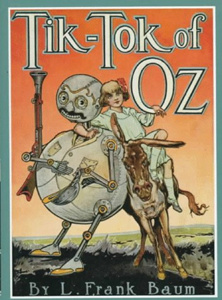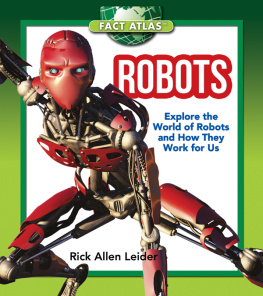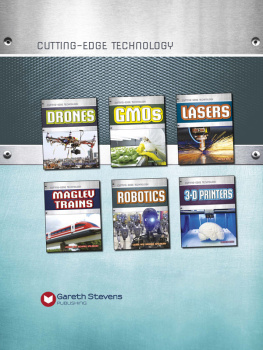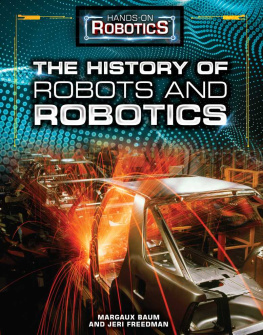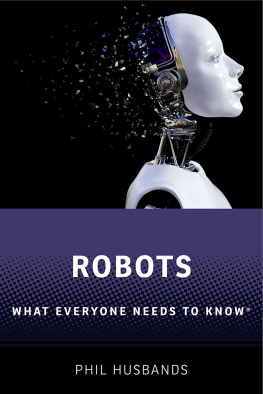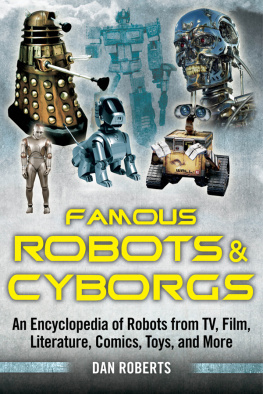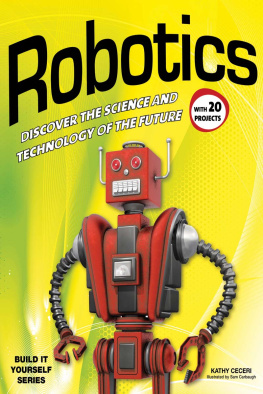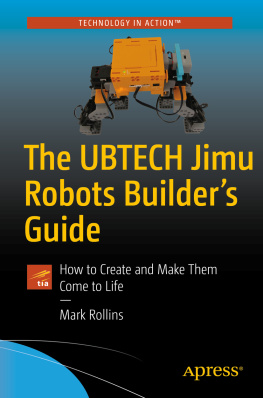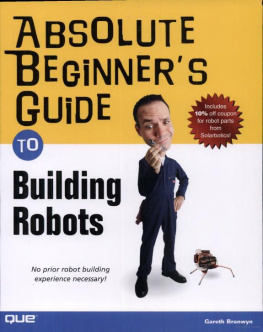Contents
Guide
Pagebreaks of the print version
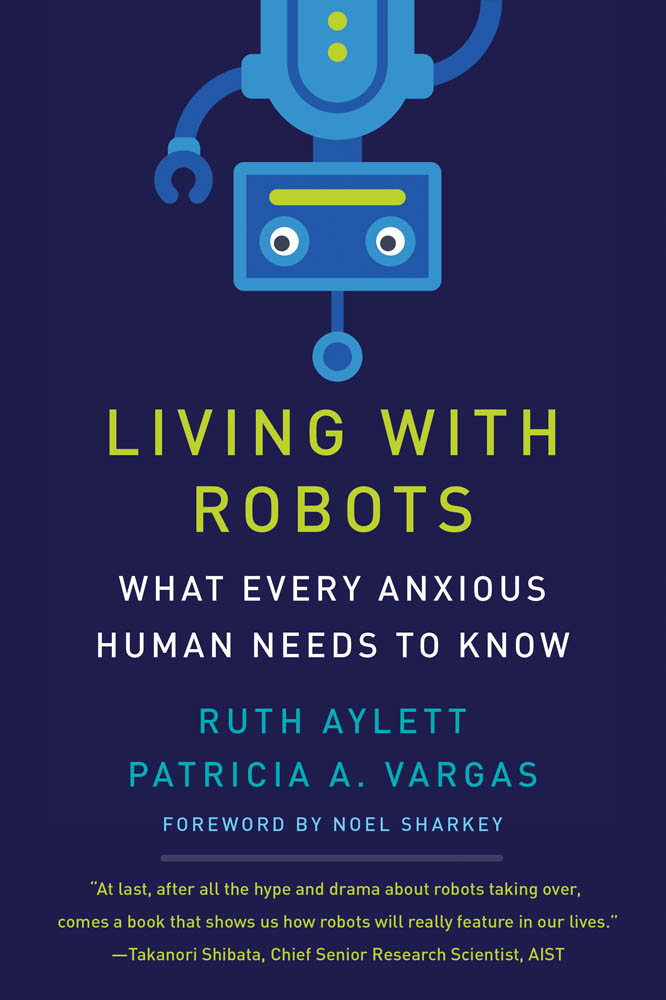
LIVING WITH ROBOTS
WHAT EVERY ANXIOUS HUMAN NEEDS TO KNOW
RUTH AYLETT AND PATRICIA A. VARGAS
FOREWORD BY NOEL SHARKEY
THE MIT PRESSCAMBRIDGE, MASSACHUSETTSLONDON, ENGLAND
2021 Ruth Aylett and Patricia A. Vargas
All rights reserved. No part of this book may be reproduced in any form by any electronic or mechanical means (including photocopying, recording, or information storage and retrieval) without permission in writing from the publisher.
The MIT Press would like to thank the anonymous peer reviewers who provided comments on drafts of this book. The generous work of academic experts is essential for establishing the authority and quality of our publications. We acknowledge with gratitude the contributions of these otherwise uncredited readers.
Library of Congress Cataloging-in-Publication Data
Names: Aylett, Ruth, 1951- author. | Vargas, Patricia A., 1969- author. | Sharkey, N. E. (Noel E.), writer of foreword.
Title: Living with robots : what every anxious human needs to know / Ruth Aylett and Patricia A. Vargas ; foreword by Noel Sharkey.
Description: Cambridge, Massachusetts : The MIT Press, [2021] | Includes bibliographical references and index.
Identifiers: LCCN 2020035369 | ISBN 9780262045810 (hardcover)
Subjects: LCSH: Robots--Popular works. | Artificial intelligence--Popular works.
Classification: LCC TJ211.15 .A95 2021 | DDC 629.8/92--dc23
LC record available at https://lccn.loc.gov/2020035369
d_r0
To Peter Aylett, whose example led me into computing, and Rob Jones, whose love and comradeship made it possible for me to have four children and be an active robotics researcher.RSA
To my partner, for all the support and unconditional love. You always make me feel safe and give me comfort.PAV
CONTENTS
- Noel Sharkey
LIST OF FIGURES
- This automaton is the work of another Swiss mechanician of the eighteenth century, Henri Maillardet. Known as the Draughtsman-Writer, it produces four drawings and three poems using a cam-based memory. Now in the Franklin Institute in Philadelphia.
- A modern industrial robot with two arms that can cooperate. This one has sensors to stop it from hitting anyone.
- The Pleo was a small dinosaur robot that researchers were able to develop new behaviors for.
- The Fur Hat robot is a glass model of a head with an animated face projected from inside. It is wearing a wig in this picture.
- The Baxter robot.
- . CC BY-SA 3.0.
- This robot is the work of the Japanese researcher Hiroshi Ishiguro, who specializes in very humanlike designs, mostly of young women, but including one based on himself. Many feel these provoke an uncanny valley reaction.
- This Flash robotknown as Alyxis an example of a humanoid design related more to cartoons than naturalism.
- Three graphical renderings of sensor data: (a), Stirling University from a drone, a point cloud, where each point is a number that must be processed; (b)bottom left, front lounge using a Microsoft Kinect sensor processed to show planes; (c)bottom right, road, car, trees in laser slices from lidar sensor. You can make out objects in these perhaps; that is your eyes doing clever stuff.
- Software can extract facial features if it has a model of faces telling it where to look.
- An exoskeleton to support a paraplegic. The arms are used to drive the legs forward.
- The iCub robot was developed specifically to support research in developmental robotics and is modeled on a child.
- Cheap drones support experiments with formation flying.
- The RoboCup Standard Platform League uses small-legged robots that move at a slow walking pace. Picture by Ralf Roletschek.
- Here is the iCat, this time playing chess directly with a child.
- The EMYS robot head with eleven degrees of freedom can still produce interesting expressions. It owes more to cartoons than to natural human facial expressions.
- The Sony Aibo robot was groundbreaking but intentionally not like a real dog.
- The Paro robot is sold commercially and is a successful aid for elderly sufferers of dementia.
- The commercially available Pepper robot from SoftBank Robotics has been used in experiments in shopping malls.
- Researchers at the University of Hertfordshire have used the Kaspar robot to work with children with autism. Its face is deliberately nonexpressive to reduce the stress it might otherwise cause.
FOREWORD
You might have picked up this book and are thinking, Oh, no, not another book on robotics and artificial intelligence. But before you put it down, let me tell you that it is a breath of fresh air and a book that you ought to read if you, like me, dont want to be fed the excrement of bulls.
Weve all experienced hypeextravagant and unfounded claims usually propounded for commercial purposes. I still remember my bitter disappointment over the ray gun that I really wanted for Christmas in 1957. It turned out to be a torch with three colored lights. On the positive side, it taught me a lot about the hype of advertising and made me think much more critically about my toy choices.
But this overselling seems so innocent compared to the hype today surrounding artificial intelligence (AI) and robotics. There have always been false claims and overexaggeration about the nature and abilities of robots. As early as 1927, a robot created by the US appliance company Westinghouse was widely reported in the worlds media as a new domestic slave that would be able to carry out all household chores within the next ten years. This was the first example of robot hype, but certainly not the last.
Robots tug strongly on our natural tendency to project human or animal attributes onto inanimate objects. Such anthropomorphism (or zoomorphism) has long been exploited by sales personnel and designers. We see it particularly in car design, with everything from aggressive gnashing-teeth models to cuddly family cars. Look around and see how many faces you can find. You may not realize that you are projecting animal characteristics onto objects, but those qualities affect how you see them, the way you interact with them, and which products you buy.
With robots, the anthropomorphic tug is powerful. They have the appearance of independent movementlike an animal, but a lot stiffer. Scientists have suggested that robots form a new perceptual category between inanimate and animate. And this is largely through deception. A number of humanoid-style robots on the market have been manufactured to look cartoonishly cute, with cuddly turns of the head or some other appealing gesture. They often get demonstrated at commercial fares, conferences, festivals, and even on TV with a hidden operator controlling them. They may also have scripted speech that can provide answers to questions known in advance. Sometimes the operator just talks through the robot in a robot voice.
Wheres the harm? Its all a bit of a laugh and good fun, isnt it? The harm lies in the creation of a mythology that grossly overestimates the capabilities of the machines. It pushes us into the possibility of a new category of being. And the massive overexaggeration around AI amplifies the overblown claims of robotics. After all, what else would be controlling our robots?


